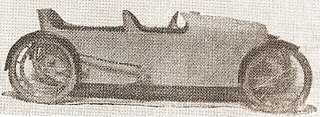Related Research Articles

A V-twin engine, also called a V2 engine, is a two-cylinder piston engine where the cylinders are arranged in a V configuration and share a common crankshaft.

A cyclecar was a type of small, lightweight and inexpensive motorized car manufactured in Europe and the United States between 1910 and the early 1920s. The purpose of cyclecars was to fill a gap in the market between the motorcycle and the car. A key characteristic was that it could accommodate only two passengers sitting in tandem.

A sliding pillar suspension is a form of independent front suspension for light cars. The stub axle and wheel assembly are attached to a vertical pillar or kingpin which slides up and down through a bush or bushes which are attached to the vehicle chassis, usually as part of transverse outrigger assemblies, sometimes resembling a traditional beam axle, although fixed rigidly to the chassis. Steering movement is provided by allowing this same sliding pillar to also rotate.

The Xenia was an American cyclecar designed by P. E. Hawkins of Cleveland and manufactured in Xenia, Ohio in 1914. The factory was Fred Baldner's machine shop, in which Baldner manufactured his own car from 1900 to 1903.
The term light car is used in Great Britain since the early part of the 20th century for an automobile less than 1.5 litres engine capacity. In modern car classification this term would be roughly equivalent to a subcompact car. There are numerous light car clubs in Britain and Australia.
Grahame-White was an early British aircraft manufacturer, flying school and later manufacturer of cyclecars.
Baughan was a British cyclecar and motorcycle manufacturer in business from 1920 until 1936. Founded in 1920 in Harrow, Middlesex, from 1921 the company moved to Stroud, Gloucestershire. After motorcycle production finished the company continued in general engineering and plastics.
Air Navigation and Engineering Company Limited was a British aircraft manufacturer from its formation in 1919 to 1927.
The Davis was an American cyclecar manufactured in Detroit, Michigan, by the Davis Cyclecar Company in 1914. The car used a two-cylinder Spacke air-cooled engine, and featured three-speed selective transmission and a double chain drive on a 93-inch wheelbase. The Davis was similar to the French Bédélia in that the driver sat in the rear seat. The tandem two-seater cost $425, but designer William Norris Davis was unable to secure the capital to undertake production. He moved to the West Coast and joined the Los Angeles Cyclecar Company.
The Detroit Cyclecar was a cyclecar manufactured in Detroit, Michigan by the Detroit Cyclecar Company from 1913 to 1914 and Saginaw, Michigan in 1914.

The JPL was a brass era cyclecar built in Detroit, Michigan by the J.P.L. Cyclecar Company, formed in 1913. Production started in December 1913 but ended in 1914.

The Mercury was a cyclecar built in Detroit, Michigan, by the Mercury Cyclecar Company at 807 South Scotten Street in 1913-1914.

Scripps-Booth was a United States automobile marque based in Detroit, Michigan. Established by James Scripps Booth in 1913, Scripps-Booth Company produced motor vehicles and was later acquired by General Motors, becoming a division of it, until the brand was discontinued in 1923.

The Campion Cycle Company was a British bicycle, cyclecar and motor cycle maker, active from 1893 to 1926 and based in Nottingham, England. In 1927 it was purchased by Currys.
This is a chronological index for the start year for motor vehicle brands. For manufacturers that went on to produce many models, it represents the start date of the whole brand; for the others, it usually represents the date of appearance of the main model that was produced.
The Greyhound Cyclecar Company was created in 1914 in Toledo, Ohio.
The Hoover Cyclecar was a cyclecar manufactured by H. H. Hoover in St. Louis, Missouri; a company was established to manufacture the vehicle in October 1913. It was a two-passenger vehicle powered by a single-cylinder, 5 horsepower (3.7 kW) engine. Fitted with wire wheels, the engine drove the vehicle via a chain drive, with a wheelbase of 84 inches (210 cm) and a weight of 350 pounds (160 kg).

The Pope Model L was a motorcycle produced by Pope Manufacturing Company in Westfield, Massachusetts, between 1914 and 1920.

Robert Marie Georges Sénéchal was a French industrialist/motor manufacturer, racing driver and pilot, noted for the car company bearing his name and for being the winner of the first-ever British Grand Prix.
References
- ↑ Georgano, Nick (2000). The Beaulieu Encyclopedia of the Automobile. Norwich: The Stationery Office. p. 131. ISBN 0-11-702319-1.
- ↑ Kay, Stephen (2009). Cyclecars - An Annoted Index. Govilon: 325 Press. p. 24. ISBN 978-09563160-0-4.